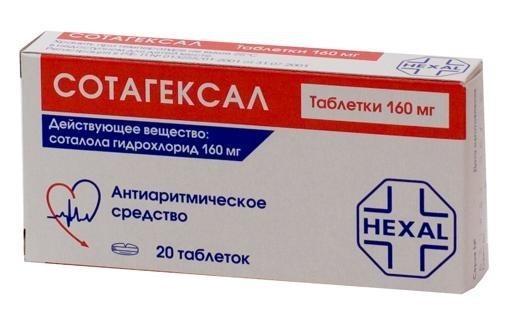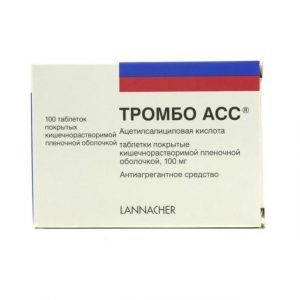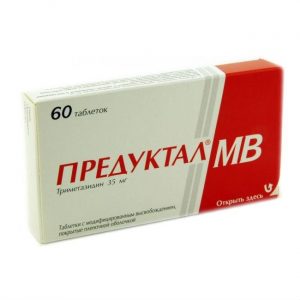Description
Release form
Tablets.
Packing
20 pcs.
Pharmacological action
SotaHEXAL has an antiarrhythmic effect. Blocks beta1- and beta2-adrenergic receptors. Reduces heart rate, myocardial contractility, slows AV conduction. SOTAHEXAL increases the tone of the smooth muscles of the bronchi.
Indications
Supraventricular tachyarrhythmia: nodal tachycardia, tachycardia with WPW syndrome, paroxysmal atrial fibrillation, ventricular tachycardia, ventricular extrasystole.
Contraindications
Hypersensitivity (including to sulfonamides), chronic heart failure of the IIb-III stage, shock, AV block of the II-III degree, sinoatrial block, sinus node weakness syndrome, bradycardia, prolongation of the QT interval, hypokalemia, hypotension, severe peripheral circulation disorders, obstructive respiratory diseases (including bronchial asthma), metabolic acidosis, laryngeal edema, myasthenia gravis, severe allergic rhinitis.
Use during pregnancy and lactation
In the first trimester of pregnancy, it is possible for strict medical reasons, with a thorough analysis of all risk factors. At the time of treatment should stop breastfeeding.
Special instructions
Caution should be exercised when prescribing Sotagexal to patients: – with a history of diabetes mellitus with severe fluctuations in blood glucose, and also with strict
diets – with pheochromocytoma (simultaneous administration of alpha-blockers is necessary)
– with a history or family history of psoriasis
– with impaired renal function
– elderly.
Treatment with the drug is carried out under the control of heart rate, blood pressure, ECG. With a marked decrease in blood pressure or a decrease in heart rate, the daily dose should be reduced.
Patients with impaired renal function require dosage adjustment.
Cancellation of Sotagexal should be carried out under the supervision of the attending physician and gradually (especially after prolonged use).
Sotagexal should not be used in patients with hypokalemia or hypomagnesemia until the correction of existing disorders. These conditions may increase the degree of lengthening of the QT interval and increase the likelihood of pirouette type arrhythmias. It is necessary to control the electrolyte balance and acid-base state in patients with severe or prolonged diarrhea and in patients receiving drugs that cause a decrease in the content of magnesium and / or potassium in the body.
With thyrotoxicosis, sotalol may mask certain clinical signs of thyrotoxicosis (eg, tachycardia). Abrupt withdrawal in patients with thyretoxicosis is contraindicated, since it can enhance the symptoms of the disease.
Caution should be exercised when prescribing beta-blockers to patients receiving hypoglycemic agents, since hypoglycemia may develop during prolonged interruptions in food intake, and such symptoms, like tachycardia or tremor, can be masked by the action of the drug.
Composition
1 tab. contains sotalol hydrochloride 160 mg.
Dosage and administration of
SOTAHEXAL is taken orally, before meals, without chewing, drinking plenty of fluids, 80-120 mg / day. in 2-3 doses. With insufficient effectiveness – up to 160-240-320 mg / day. in 2-3 doses. In severe arrhythmias, up to 480 mg / day. in 2-3 doses. The dose increase should be carried out with an interval of 2-3 days.
Side effects
From the nervous system and sensory organs: dizziness, headache, tiredness, sleep disturbance, confusion, paresthesia, depression. Inflammation of the cornea and conjunctiva (should be considered when wearing contact lenses), visual impairment (extremely rare), decreased tearing.
From the cardiovascular system and blood (hematopoiesis, hemostasis): heart failure, bradycardia, AV block, angina pectoris (in rare cases), hypotension.
From the respiratory system: bronchospasm.
From the digestive tract: nausea, diarrhea, constipation, dry mouth.
From the side of metabolism: hypoglycemia (more often in patients with diabetes mellitus or with strict adherence to a diet).
From the genitourinary system: decreased potency.
From the musculoskeletal system: a feeling of coldness in the limbs, muscle weakness or cramps.
On the part of the skin: skin rash, itching (rarely) redness, psoriasiform dermatosis, alopecia.
Drug Interactions
With the simultaneous administration of slow calcium channel blockers such as verapamil and diltiazem, a decrease in blood pressure is possible as a result of worsening contractility. I / O administration of these drugs should be avoided with the use of sotalol (except in cases of emergency medicine).
The combined use of class IA antiarrhythmic drugs (especially the quinidine type: disopyramide, quinidine, procainamide) or class III (e.g. amiodarone) can cause a pronounced lengthening of the QT interval. Drugs that increase the duration of the QT interval should be used with caution with drugs that extend the QT interval, such as class I antiarrhythmics, phenothiazines, tricyclic antidepressants, terfenadine and astemizole, as well as some quinolone antibiotics.
With the simultaneous administration of nifedipine and other derivatives of 1,4-dihydropyridine, a decrease in blood pressure is possible.
Concomitant administration of norepinephrine or MAO inhibitors, and abrupt cancellation of clonidine can cause arterial hypertension. In this case, the abolition of clonidine should be carried out gradually and only a few days after the end of taking Sotageksal.
Tricyclic antidepressants, barbiturates, phenothiazines, opioid and antihypertensive agents, diuretics and vasodilators can cause a sharp decrease in blood pressure.
Use of funds for inhalation anesthesia, incl. tubocurarine while taking Sotagexal increases the risk of inhibition of myocardial function and the development of arterial hypotension.
With the simultaneous use of Sotagexal with reserpine, clonidine, alpha methyldopa, guanfacine and cardiac glycosides, the development of severe bradycardia and a slowdown in the excitation in the heart are possible.
Beta-blockers can potentiate hypertension withdrawal, after discontinuation of clonidine, therefore beta-blockers should be discontinued gradually, a few days before the gradual discontinuation of clonidine.
Prescribing insulin or other oral hypoglycemic agents, especially during physical exertion, can lead to increased hypoglycemia and the manifestation of its symptoms (increased sweating, rapid pulse, tremor). In diabetes mellitus, dose adjustment of insulin and / or hypoglycemic drugs is necessary.
Potassium-excreting diuretics (e.g. furosemide, hydrochlorothiazide) can trigger arrhythmias caused by hypokalemia.
Concomitant use with Sotagexal may require the use of higher doses of beta-adrenergic agonists such as salbutamol, terbutaline and isoprenaline.
Overdose
Symptoms: decreased blood pressure, bradycardia, bronchospasm, hypoglycemia, loss of consciousness, generalized seizures, ventricular tachycardia in severe cases – symptoms of cardiogenic shock, asystole.
Treatment: gastric lavage, hemodialysis, appointment of activated charcoal. Symptomatic therapy: atropine – 1-2 times in / in jet glucagon – first as a short infusion at a dose of 0.2 mg / kg body weight, then at a dose of 0.5 mg / kg body weight / infusion for 12 h
Storage Conditions
In a dark place at a temperature not exceeding 25 ° C.
active substance
sotalol
Terms leave around drugstore
prescription
PMA pills
sandoz, switzerland




